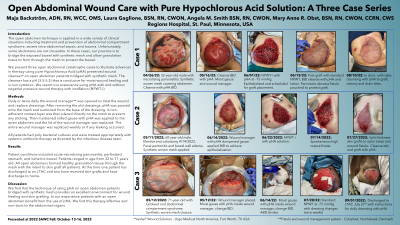Case Series/Study
(CS-105) Open abdominal wound care with pure hypochlorous solution: a series of three.

The open abdomen technique is applied in a wide variety of clinical situations including treatment and prevention of abdominal compartment syndrome, severe intra-abdominal sepsis, and trauma. Unfortunately some abdomens are un-closeable. In these cases, our practice is to bridge the exposed bowel with synthetic mesh and allow granulation tissue to form through the mesh to protect the bowel.
We present three open abdominal catastrophe cases to illustrate advances in therapy using pure Hypochlorous Acid (pHA) preserved wound cleanser* on open abdomen patients bridged with synthetic mesh. The cleanser has a pH (3.5-5.5) that is conducive for wound healing and is non-cytotoxic. We report our experience using pHA with and without negative pressure wound therapy with instillation (NPWT-i).
Methods:
Daily or twice daily the wound manager** was opened to treat the wound and replace dressings. After removing the old dressings, pHA was poured onto the mesh and suctioned from the base of the dressing. A non-adherent contact layer was then placed directly on the mesh to prevent any sticking. Then moistened rolled gauze with pHA was applied to the open abdomen and the lid of the wound manager was replaced. The entire wound manager was replaced weekly or if any leaking occurred.
All patients microbiology had poly bacterial cultures and were treated appropriately with systemic antibiotic therapy as directed by the infectious disease team.
Results:
Patient conditions included acute necrotizing pancreatitis, perforated stomach, and ischemic bowel. Patients ranged in age from 32 to 71 years old. All open abdomens formed healthy granulation tissue through the mesh and the intent is to skin graft all patients. At this time, one patient has discharged to an LTAC, one has received a skin graft with and is planned to discharge to home in one week, and one remains in the ICU.
Discussion:
We find that the technique of using pHA on open abdomen patients bridged with synthetic mesh provides an excellent environment for wound healing and skin grafting. In our experience patients with an open abdomen benefit from the use of pHA. We find this therapy effective and non-toxic to the abdominal organs.
Trademarked Items:
References: 1. Coccolini, F., Gubbiotti, F., Ceresoli, M., Tartaglia, D., Fugazzola, P., Ansaloni, L., Sartelli, M., Kluger, Y., Kirkpatrick, A., Amico, F., Catena, F., Chiarugi, M., & IROA study group (2020). Open Abdomen and Fluid Instillation in the Septic Abdomen: Results from the IROA Study. World journal of surgery, 44(12), 4032–4040. https://doi.org/10.1007/s00268-020-05728-3
2. Guillen B, Cassaro S. Traumatic Open Abdomen. [Updated 2021 Jul 15]. In: StatPearls [Internet]. Treasure Island (FL): StatPearls Publishing; 2022 Jan-. Available from: https://www.ncbi.nlm.nih.gov/books/NBK470292/
3. Diaz, Jose J. Jr. MD; Cullinane, Daniel C. MD; Dutton, William D. MD; Jerome, Rebecca MS; Bagdonas, Richard MD; Bilaniuk, Jarolslaw O. MD; Collier, Bryan R. DO; Como, John J. MD; Cumming, John MD; Griffen, Maggie MD; Gunter, Oliver L. MD; Kirby, John MD; Lottenburg, Larry MD; Mowery, Nathan MD; Riordan, William P. Jr. MD; Martin, Niels MD; Platz, Jon MD; Stassen, Nicole MD; Winston, Eleanor S. MD The Management of the Open Abdomen in Trauma and Emergency General Surgery: Part 1—Damage Control, The Journal of Trauma: Injury, Infection, and Critical Care: June 2010 - Volume 68 - Issue 6 - p 1425-1438 doi: 10.1097/TA.0b013e3181da0da5

.png)